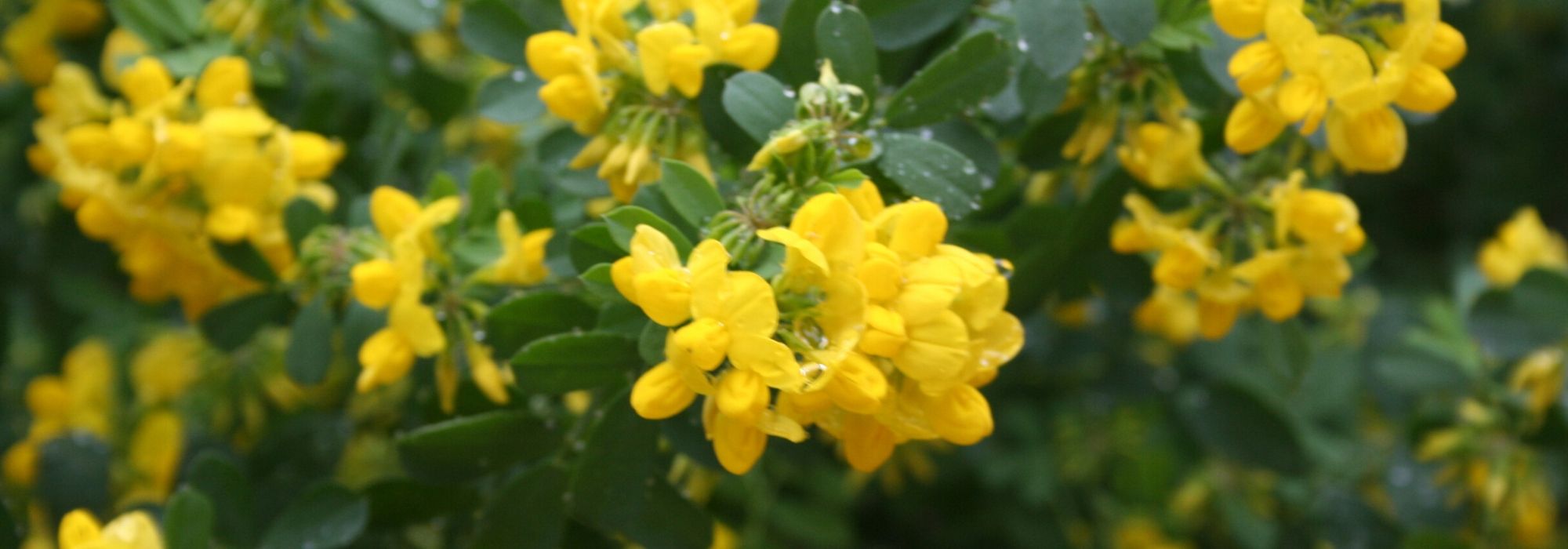
Coronille, Coronilla: planting, growing and care
Contents
Coronilla in a nutshell
- Coronilla is a small bush with long, scented flowering, usually yellow, from spring to autumn
- It is one of the easiest bushes to grow, tolerating a stony or sandy garden where few plants will grow
- It thrives in well-draining soils, even those that are dry in summer and poor
- Robust, hardy, perfectly adapted to drought and undemanding, it finds its place in most gardens
- A reliable choice in rockeries, bushy borders, embankments or flowering hedges
A word from our expert
Coronilla (in Latin Coronilla) is a small bushy bush prized for its sunny, fragrant flowering that lasts several weeks, from early spring to autumn, depending on species. The shrubby Coronilla or garden Coronilla (Coronilla emerus, syn. Hippocrepis emerus) can reach 2 m high while Coronilla valentina subsp. glauca, also called glaucous Coronilla, will not exceed 1 m in height and makes a striking display in a large pot on the terrace. Some Coronilla such as Coronilla valentina glauca ‘Variegata’ or variegated Coronilla are distinguished by cream-white variegated foliage, while Coronilla bigarrée is easily recognisable by its flowers variegated with pink, white and purple.
If Coronilla belongs to family Fabaceae, commonly called legumes and which includes beans or peas, it is not edible.
Mediterranean plant, Coronilla is sun-loving and undemanding, fearing neither poor soil nor cold. Very hardy and highly drought-resistant, it likes permeable, even stony, well-drained soils.
With its attractive bushy silhouette, Coronilla is perfect for quickly creating a luminous pit in all dry gardens and without watering.
Discover our selection now!
Description and botany
Botanical data
- Latin name Coronilla, Hippocrepis
- Family Fabaceae
- Common name Coronilla, False Baguenaudier, Bastard senna
- Flowering April to October
- Height 0.15 to 2 m
- Exposure Sun, partial shade
- Soil type Stony (poor and free-draining), dry soil
- Hardiness -10°C-15°C
Coronilla, also called “false baguenaudier” or “bastard senna”, is a small bush of family Fabaceae, like mimosas, native to garrigues, woodland edges and limestone slopes of Mediterranean basin, sometimes up to 1 300 m altitude. Genus Coronilla (or Hippocrepis) includes about twenty deciduous or evergreen species, among which garden coronilla or Coronilla emerus (syn. Hippocrepis emerus), Coronilla glauca and its hybrids such as Coronilla valentina subsp. glauca (‘Citrina’, ‘Variegata’) and variegated Coronilla are most commonly grown in gardens. Coronilla emerus grows wild in some southern regions of France and is a protected species in Dordogne and Gironde.
From a woody stump, Coronilla forms a very bushy shrub with dense, ramified habit about 1 m to 2 m high, tending to spread with age. Coronilla minima, a dwarf coronilla, does not exceed around ten centimetres in height. Fast-growing, lifespan of this small plant is relatively short, 5 to 10 years at most.
Rameaux of medium green, thin and ramified, bear deciduous leaf in Coronilla emerus, semi-persistent to evergreen in Coronilla glauca. It is composed of alternate, pinnate leaves 3 to 6 cm long, divided into 7 to 9 small ovate or oblong leaflets.
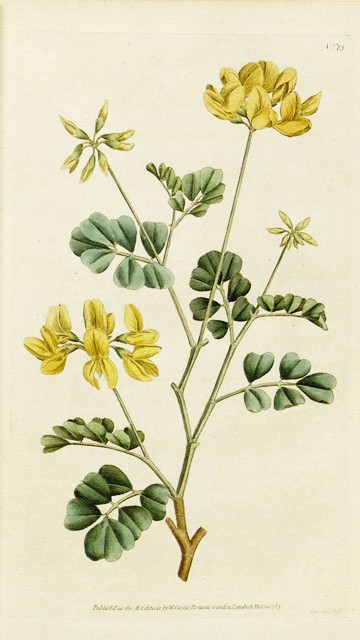
Coronilla valentina – botanical illustration
Bright green or spinach green with a matt finish in Coronilla emerus, leaves take a bluish-green colour in glaucous coronillas and variegate cream-white in variegated Coronilla (Coronilla valentina glauca ‘Variegata’).
Elegantly cut, this light leaf provides backdrop to a sunny, abundant yet elegant flowering. Flowers appear from January in mild climates for earliest coronillas, and open in successive waves in spring and summer, as long as heat and drought do not set in, sometimes until first frosts. They are gathered, depending on species, in umbels of 5 to 8 flowers at branch tips or axillary, grouped 2 to 4 in leaf axils.
These small 5-petalled flowers, typical of papilionaceous group, resemble those of brooms or cytises (Laburnum). Butterfly-shaped, 1 to 2 cm long and composed of 4 petals, the upper and largest petal unfolds as a banner above two lateral petals or wings that close to form a keel. Set in a calyx often flushed with red, most often a very bright sun-yellow, bordering on garish, these pea-type flowers range from purple to pink and white in variegated Coronilla, and are sometimes streaked with red and brown in garden coronilla. They give off a sweet, floral scent like broom, perfuming surrounding area. Highly melliferous, they attract many pollinating insects.
This generous flowering gives way to slender pendulous pods ending in a long beak, called siliqua, curved and darkening to almost black, measuring up to 10 cm long. They turn brown and split open at ripeness, ejecting small cylindrical seeds capable of self-seeding in garden.
Easy to grow, Coronilla is hardy to at least -10°C, most often to -15 to -20°C, and grows in all exposures, though it prefers warm, very sunny positions. Perfectly suited to poor soils, it is an excellent plant for a dry garden and will suit a wild garden, flower garden or no‑irrigation garden, bringing a very bright, fragrant note. It is planted in shrub borders or flower beds, in large rockeries, woodland edges or in shaded or difficult areas of a dry, warm garden.
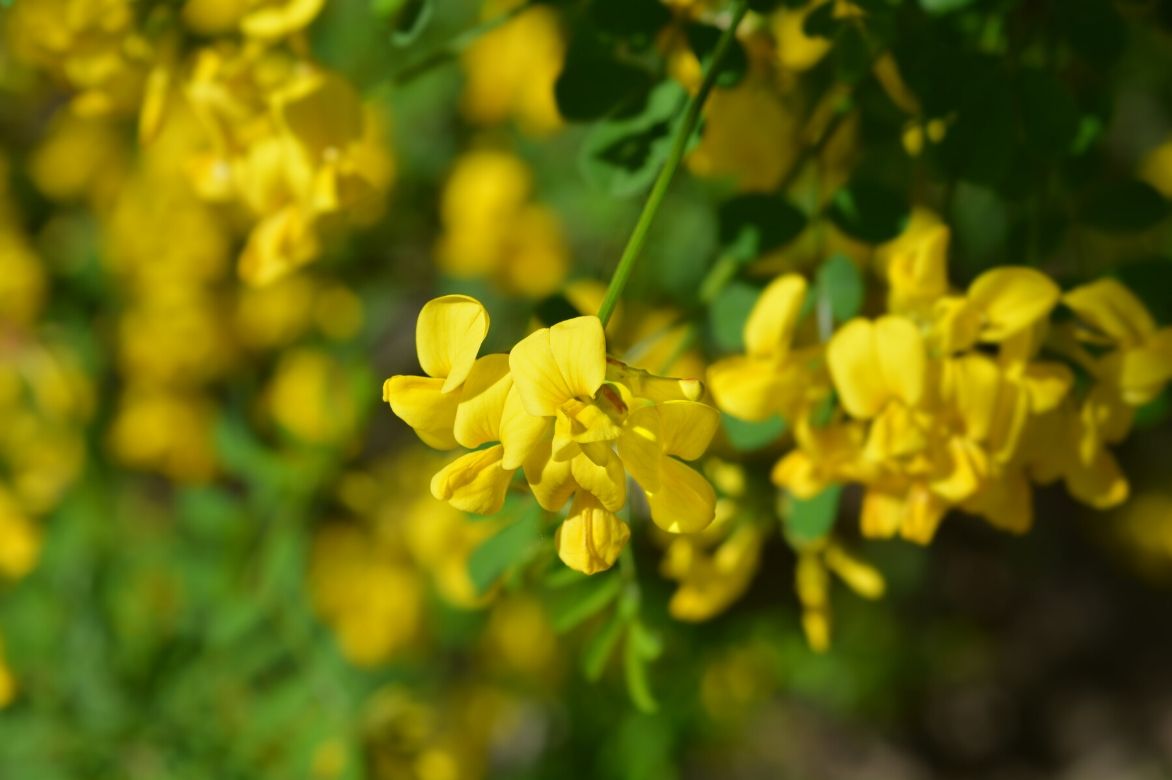
Flowering of a Coronilla
Read also
12 bushes for dry or free-draining soilMain species and varieties
There are around 6 Coronilla species, the most widespread in our gardens being garden coronilla (Coronilla emerus), deciduous in winter but hardy, and Coronilla glauca or glaucous coronilla, with glaucous green-blue evergreen foliage, more moderate in growth, and its hybrids; Coronilla glauca ‘Citrina’ with pale yellow flowers or Coronilla glauca ‘Variegata’ with variegated leaves. Some offer an early flowering that starts as early as January in mild climate and continues until April; others flower in April–May, followed by sporadic repeat blooms into autumn, even almost all year round.
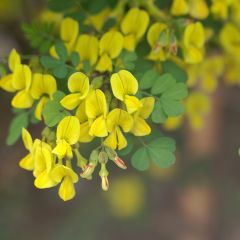
Hippocrepis emerus
- Flowering time May to August
- Height at maturity 1,75 m
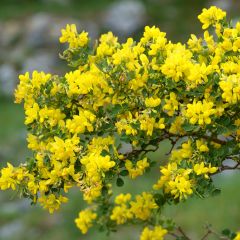
Coronilla valentina subsp. glauca
- Flowering time May, June
- Height at maturity 1 m
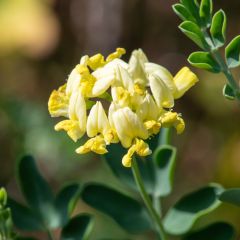
Coronilla valentina subsp. glauca Citrina
- Flowering time May to November
- Height at maturity 1,10 m
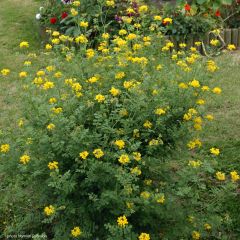
Coronilla valentina subsp. glauca Selection
- Flowering time May to December
- Height at maturity 1 m
Discover other Coronilla
View all →Available in 1 sizes
Available in 1 sizes
Available in 1 sizes
Available in 1 sizes
Available in 1 sizes
Planting
Where to plant Coronilla?
Hardy, Coronilla tolerates temperatures below -15°C, sometimes down to -20°C in perfectly well-drained soil, because excess winter water can harm this shrub’s hardiness. Resistant to disease, cold, sea spray and summer drought, it is easy to grow in almost all regions. In the coldest areas, protect it from frost as much as possible by siting it in a warm part of the garden, in full sun or against a south-facing wall.
It likes warm situations and is best planted in sun, even hot sun where it will flower better, although it tolerates light shade and even deeper shade in warm regions: it does not fear soils riddled with roots and will even appreciate a spot beneath a large tree.
Regarding soil, Coronilla is a deciduous bush appreciated for its undemanding nature. It thrives in all well-drained soils — light, even poor, dry and stony. It adapts easily to poor or degraded soils, which it colonises.
Regarding position, Coronilla is not bothered by root competition from large trees such as pines or oaks, and will thrive where few plants will grow. It tends to spread over time; allow about 1.5 m of space in all directions so it can develop comfortably. In the coldest regions, growing in large pots that are stored over winter is possible.
It is an excellent plant for dry, stony and waterwise gardens, a no-irrigation garden, to install in a shrub or mixed flower border, as a hedge, on a stony bank or in a light woodland.
When to plant Coronilla?
Plant Coronilla in early spring, in March–April north of the Loire, after the last frosts, and in September–October in southern regions of France.
How to plant Coronilla?
In open ground
Coronilla needs well-drained soil in winter as it dislikes stagnant moisture. In heavy soil, improve with turf, pumice, a little sand or gravel at the bottom of the planting hole. For hedges and borders, depending on the variety, space plants about 1 to 1.5 m apart on average.
- Prepare soil well
- Dig a hole 2 to 3 times wider than the pot
- Spread a drainage layer (pumice, gravel, clay pebbles) at the bottom of the hole
- Plant the bush in the centre of the hole and backfill
- Firm down
- Water abundantly at planting then regularly but sparingly the first summer to encourage rooting
In a pot
Certain varieties with moderate growth and a more compact habit (Coronilla glauca ‘Citrina’) will make a striking display in a large pot on the terrace.
- In the base of a large container at least 70 cm in diameter, ensure good drainage (gravel or clay pebbles)
- Plant in a light potting mix
- In summer, water well during flowering, once to twice a week without drowning the plant and allowing the substrate to dry between waterings
Maintenance, pruning and care of Coronilla
Coronilla requires little maintenance once well established.
It offers good drought resistance so does not require heavy watering except during the first summer when you should water it once or twice a week to help it establish. Afterwards, water only in case of prolonged drought or periods of high heat. Undemanding, it needs no fertiliser and grows very well in poor soils. In the coldest regions, mulch in winter to protect it from frost and keep its roots warm.
Coronilla is very hardy and suffers neither disease nor parasitic attack. It is only vulnerable to excess moisture: to avoid root rot, ensure soil is sufficiently well drained.
When and how to prune Coronilla
Pruning of Coronilla is not essential but can be useful to limit growth, prevent it from becoming bare and keep an attractive shape. It is a fairly short-lived plant; it will last longer and flower better if you carry out an annual pruning, but avoid pruning too severely. If you wish to keep the seeds, prune just after fruiting.
- With shears, tip back the stems after flowering, from late June to September, to encourage the plant to ramify, densify the foliage and maintain a balanced silhouette
- Older Coronillas can be cut back more severely to 20 cm above the soil from February to April, before growth resumes
Multiplication
If Coronilla multiplies by sowing in March or in autumn with harvested seeds, we also recommend propagation by cuttings, simplest and quickest method to renew plants that age fairly quickly. It suckers very easily and self-seeds spontaneously but often lives only a few years, so benefits from being propagated to ensure longevity.
Sowing Coronilla
Harvest seeds of Coronilla when ripe in autumn and sow them under cold frame or store them in the fridge (at 4 °C) to break their dormancy and favour germination as they require stratification. Sow them in early spring in buckets in a mix of potting compost and sand. Plant out following autumn.
Propagation by cuttings
- In June, take firm green non-flowering shoots 10 to 15 cm long
- Scrape bark over a few centimetres and remove lower leaves
- Keep two pairs of upper leaves
- Plant these herbaceous cuttings in buckets in a light, free-draining mix of coarse sand and potting compost and place under a transparent plastic bag
- Keep substrate slightly moist until rooting
- Pot up cuttings individually in autumn into larger pots filled with potting compost
- Keep sheltered from frost over winter
- Plant out in ground in spring and water well during first year
Associating
Coronilla is an attractive shrub for poor soils that can be used in borders, rockeries, flowering hedges, in a shrub or flower bed and will find its place in all natural and wild gardens where it will be a pretty source of light. In garden, its sunny flowering will take over from Forsythias and Japanese quince. Depending on variety, it will contribute to spring scenes from the end of winter or to summer ones. In garden, its yellow flowers will set off all blue flowering.

An example of planting in a flowering hedge: Photinia serrulata, Coronilla (Coronilla emerus for example), Choisya ternata and Abelia grandiflora
With its early flowering, Coronilla glauca ‘Citrina’ can be paired with late flowers of spring bulbs such as botanical tulips and fritillaries. Its flowering will stand out strongly in gold/blue combinations with blue flowers of Caucasian forget-me-nots, Scilla sibirica or muscari in spring, then Perovskia, Geranium macrorrhizum, Convolvulus cneorum, Italian buglosses or Ceratostigma. It works wonders at the edge with Campanula portenschlagiana and basket-of-gold.
In a bush border, pair it with sun-loving bushes for dry, poor soil such as Cistus, Caryopteris, and in an unwatered garden on a large bank with other groundcovers such as Broom, rosemary or creeping ceanothus or a creeping rose. As centrepiece in a bed of low or mat-forming plants, it will be magnificent surrounded by perennials and rockery plants, small cistus (Cistus x pulverulentus, Cistus x skanbergii), dwarf or creeping conifers beside which Coronilla will form a remarkable contrast.
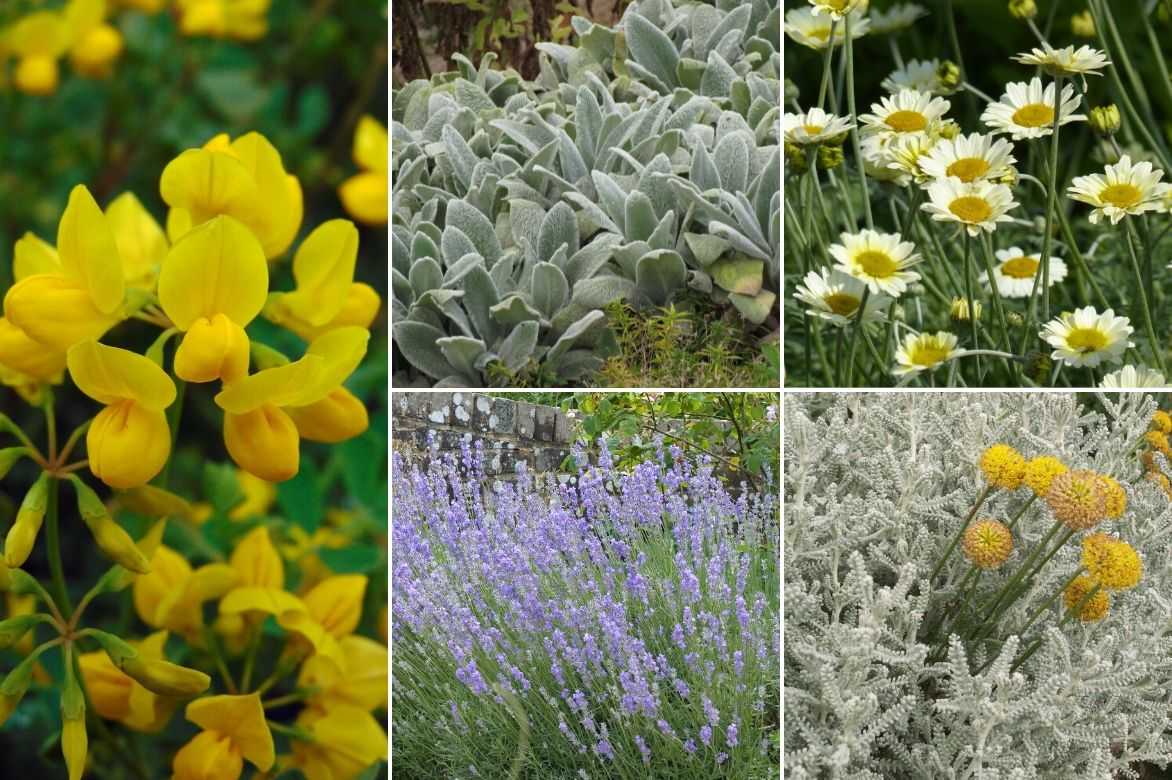
An example of planting in a bed: Coronilla valentina Glauca which will flower in spring, accompanied by fine Lavenders ‘Munstead’, Anthemis ‘Sauce Hollandaise’ which will take over, some Santolinas and a tapetum of Stachys byzantina
To compose a bed in yellow tones, place it near dry-soil euphorbias, potentillas or white or yellow roses, helianthemums or St John’s wort.
Create an evergreen and fragrant bed to accompany your glaucous Coronillas, blending foliage and scents of lavenders, silver artemisias, blue rosemary and thymes. In a large, well-drained rockery, it can be associated in natural areas with Echium candicans or Pride of Madeira.
It can serve as a focal point at the centre of a small garden or in a pot on a terrace mixed with lavenders, Stachys or artemisias.
Useful resources
- What to plant in poor, stony soil? Discover our plants resistant to lack of water!
- Coronilla is perfect in a low-maintenance garden
- Which plants to pair with your Coronilla plants? Discover how to create a dry garden
- Dare to try contrasting blue/yellow combinations!
- Follow our tips to embrace yellow in the garden!
- Subscribe!
- Contents
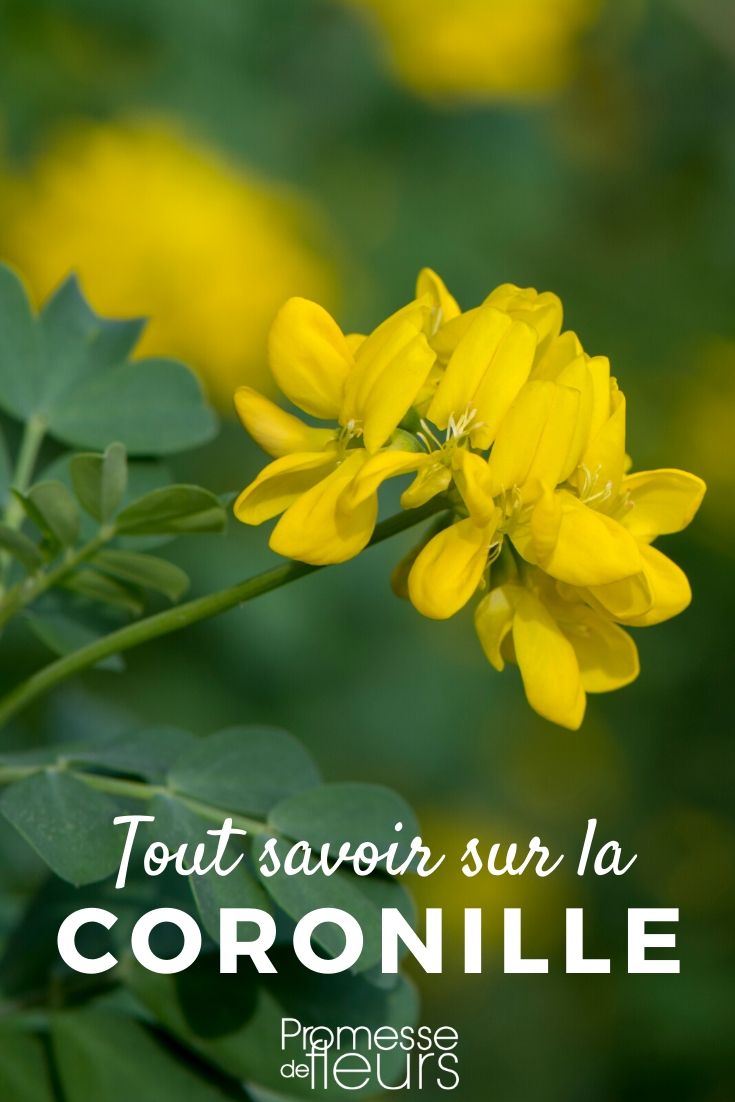


































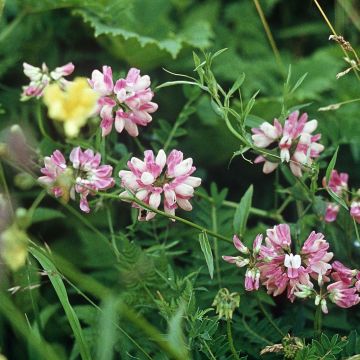

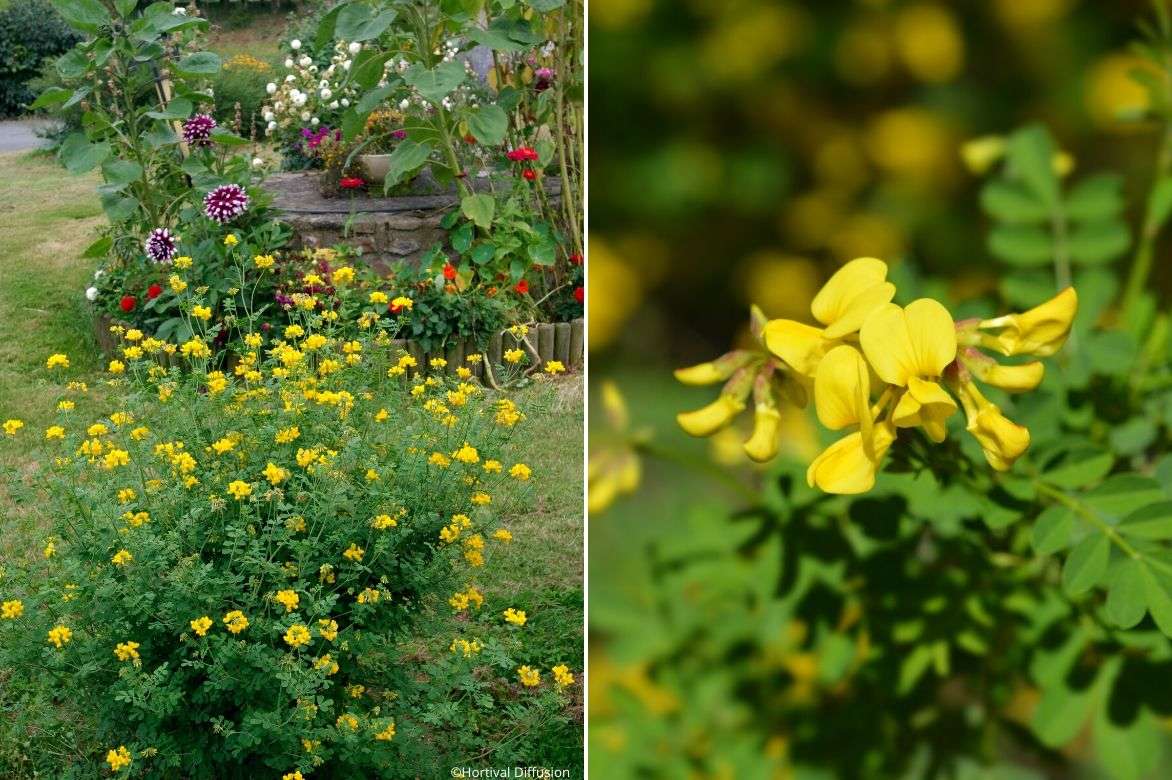
Comments